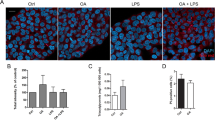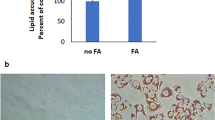Abstract
Abnormal fatty acid metabolism is observed throughout nonalcoholic fatty liver disease (NAFLD) pathogenesis, and fatty acid storage is an important inducing factor in insulin resistance, lipid oxidation, hepatic cell damage, and inflammation. During NAFLD pathogenesis, changes in blood and liver contents of different fatty acid types also vary. Cytochrome P450 2A5 (CYP2A5), an important enzyme in mouse liver, metabolizes many drugs and activates multiple pro-carcinogens with widely varying structures. According to the changes in liver fatty acid profiles observed in NAFLD animal models developed in our laboratory and others, saturated (PA/palmitic, and SA/stearic acids) and unsaturated (OA/oleic, LA/linoleic, ALA/α-linolenic and AA/arachidonic acids) fatty acids were selected to induce mouse primary hepatocytes, at concentrations under 1 mM, as detected by MTT assay. After 24 h treatment with various fatty acid concentrations and types, CYP2A5 mRNA and protein amounts, and enzyme activity were determined by real-time PCR, Western blot, and Coumarin 7—hydroxylation, respectively. Meanwhile, Nrf2 mRNA and protein levels were evaluated by real-time PCR and Western blot. The results indicated that saturated fatty acids are more potent in inducing CYP2A5 than unsaturated ones, except arachidonic acid. In addition, the changes in CYP2A5 expression were consistent with the alterations observed in Nrf2 expression, indicating that Nrf2 might play a regulatory role in CYP2A5 expression.




Similar content being viewed by others
Abbreviations
- Nrf2:
-
Nuclear factor erythroid 2-like 2
- P450:
-
Cytochrome P450
- NAFLD:
-
Nonalcoholic fatty liver disease
- FAs:
-
Fatty acids
- PA:
-
Palmitic acid
- SA:
-
Stearic acid
- OA:
-
Oleic acid
- LA:
-
Linoleic acid
- ALA:
-
α-linolenic acid
- AA:
-
Arachidonic acid
References
Abu-Bakar A, Satarug S, Marks GC, Lang MA, Moore MR (2004) Acute cadmium chloride administration induces hepatic and renal CYP2A5 mRNA, protein and activity in the mouse: involvement of transcription factor NRF2. Toxicol Lett 148(3):199–210
Abu-Bakar A, Lamsa V, Arpiainen S, Moore MR, Lang MA, Hakkola J (2007) Regulation of CYP2A5 gene by the transcription factor nuclear factor (erythroid-derived 2)-like 2. Drug Metab Dispos 35(5):787–794
Aitio A (1978) A simple and sensitive assay of 7-ethoxycoumarin deethylation. Anal Biochem 85(2):488–491
Angulo P (2002) Nonalcoholic fatty liver disease. N Engl J Med 346(16):1221–1231
Barreyro FJ, Kobayashi S, Bronk SF, Werneburg NW, Malhi H, Gores GJ (2007) Transcriptional regulation of Bim by FoxO3A mediates hepatocyte lipoapoptosis. J Biol Chem 282(37):27141–27154
Berger A, Roberts MA, Hoff B (2006) How dietary arachidonic- and docosahexaenoic- acid rich oils differentially affect the murine hepatic transcriptome. Lipids Health Dis 5:10
Cederbaum AI (2006) Cytochrome P450 2E1-dependent oxidant stress and upregulation of anti-oxidant defense in liver cells. J Gastroenterol Hepatol 21(Suppl 3):S22–S25
Cui Y, Wang Q, Li X, Zhang X (2013) Experimental nonalcoholic fatty liver disease in mice leads to cytochrome p450 2a5 upregulation through nuclear factor erythroid 2-like 2 translocation. Redox Biol 1(1):433–440
Das UN (2006) Essential fatty acids: biochemistry, physiology and pathology. Biotechnol J 1(4):420–439
Egnatchik RA, Leamy AK, Noguchi Y, Shiota M, Young JD (2014) Palmitate-induced activation of mitochondrial metabolism promotes oxidative stress and apoptosis in H4IIEC3 rat hepatocytes. Metabolism 63(2):283–295
Feldstein AE, Werneburg NW, Canbay A, Guicciardi ME, Bronk SF, Rydzewski R, Burgart LJ, Gores GJ (2004) Free fatty acids promote hepatic lipotoxicity by stimulating TNF-alpha expression via a lysosomal pathway. Hepatology 40(1):185–194
Fisher CD, Lickteig AJ, Augustine LM, Ranger-Moore J, Jackson JP, Ferguson SS, Cherrington NJ (2009) Hepatic cytochrome P450 enzyme alterations in humans with progressive stages of nonalcoholic fatty liver disease. Drug Metab Dispos 37(10):2087–2094
Goldberg IJ, Ginsberg HN (2006) Ins and outs modulating hepatic triglyceride and development of nonalcoholic fatty liver disease. Gastroenterology 130(4):1343–1346
Gong P, Cederbaum AI (2006) Nrf2 is increased by CYP2E1 in rodent liver and HepG2 cells and protects against oxidative stress caused by CYP2E1. Hepatology 43(1):144–153
Joshi-Barve S, Barve SS, Amancherla K, Gobejishvili L, Hill D, Cave M, Hote P, McClain CJ (2007) Palmitic acid induces production of proinflammatory cytokine interleukin-8 from hepatocytes. Hepatology 46(3):823–830
Kirby GM, Wolf CR, Neal GE, Judah DJ, Henderson CJ, Srivatanakul P, Wild CP (1993) In vitro metabolism of aflatoxin B1 by normal and tumorous liver tissue from Thailand. Carcinogenesis 14(12):2613–2620
Li Z, Berk M, McIntyre TM, Gores GJ, Feldstein AE (2008) The lysosomal-mitochondrial axis in free fatty acid-induced hepatic lipotoxicity. Hepatology 47(5):1495–1503
Malaguarnera M, Di Rosa M, Nicoletti F, Malaguarnera L (2009) Molecular mechanisms involved in NAFLD progression. J Mol Med (Berl) 87(7):679–695
Miller TA, LeBrasseur NK, Cote GM, Trucillo MP, Pimentel DR, Ido Y, Ruderman NB, Sawyer DB (2005) Oleate prevents palmitate-induced cytotoxic stress in cardiac myocytes. Biochem Biophys Res Commun 336(1):309–315
Nebert DW, Roe AL, Dieter MZ, Solis WA, Yang Y, Dalton TP (2000) Role of the aromatic hydrocarbon receptor and [Ah] gene battery in the oxidative stress response, cell cycle control, and apoptosis. Biochem Pharmacol 59(1):65–85
Park EJ, Min HY, Park HJ, Chung HJ, Ahn YH, Pyee JH, Lee SK (2011) Nuclear factor E2-related factor 2-mediated induction of NAD(P)H:quinone oxidoreductase 1 by 3,5-dimethoxy-trans-stilbene. J Pharmacol Sci 116(1):89–96
Sugden MC, Holness MJ (2008) Role of nuclear receptors in the modulation of insulin secretion in lipid-induced insulin resistance. Biochem Soc Trans 36(Pt 5):891–900
Wang X, Cao Y, Fu Y, Guo G, Zhang X (2011) Liver fatty acid composition in mice with or without nonalcoholic fatty liver disease. Lipids Health Dis 10:234
Wollenberg GK, Semple E, Quinn BA, Hayes MA (1987) Inhibition of proliferation of normal, preneoplastic, and neoplastic rat hepatocytes by transforming growth factor-beta. Cancer Res 47(24 Pt 1):6595–6599
Zhou X, Zhuo X, Xie F, Kluetzman K, Shu YZ, Humphreys WG, Ding X (2010) Role of CYP2A5 in the clearance of nicotine and cotinine: insights from studies on a Cyp2a5-null mouse model. J Pharmacol Exp Ther 332(2):578–587
Acknowledgments
We thank Dr H. Raunio (University of Kuopio, Kuopio, Finland) for generously providing antibodies against Cyp2a5. This work was supported by the Natural Science Foundation of China, Grant No. 31172369 and the Natural Science Foundation of Heilongjiang Province in China, Grant No.C201444.
Author Contributions
All authors participated in the design, interpretation of the studies, and analysis of the data and review of the manuscript; CYZ, WQJ, YX, and ZXY conducted the experiments, CYZ and WQJ wrote the manuscript, and ZXY contributed.
Author information
Authors and Affiliations
Corresponding author
Ethics declarations
Conflict of interest
The authors declare that they have no conflict of interest.
Additional information
Yizhe Cui and Qiuju Wang are contributed equally to this work.
Rights and permissions
About this article
Cite this article
Cui, Y., Wang, Q., Yi, X. et al. Effects of Fatty Acids on CYP2A5 and Nrf2 Expression in Mouse Primary Hepatocytes. Biochem Genet 54, 29–40 (2016). https://doi.org/10.1007/s10528-015-9697-6
Received:
Accepted:
Published:
Issue Date:
DOI: https://doi.org/10.1007/s10528-015-9697-6




